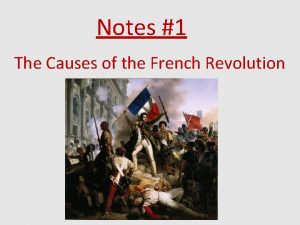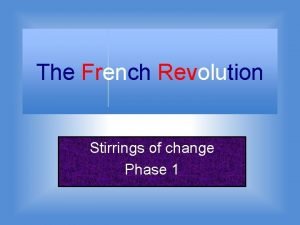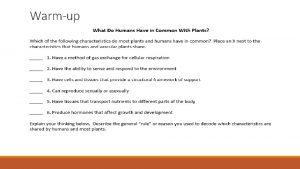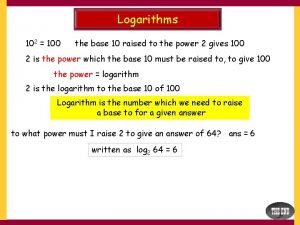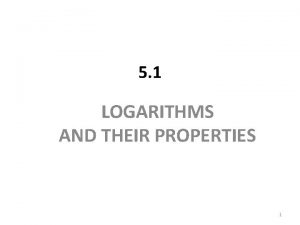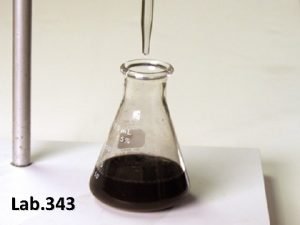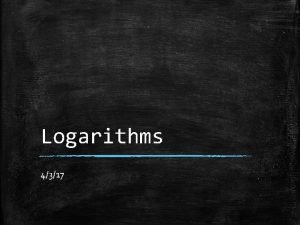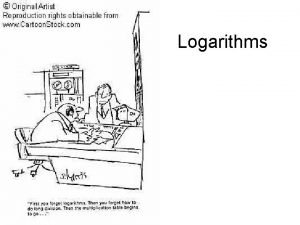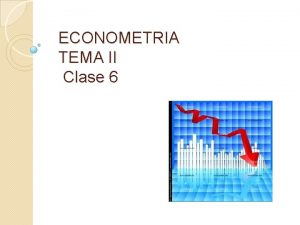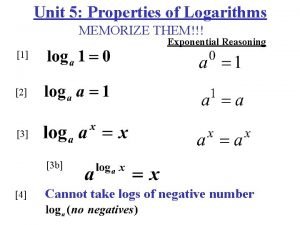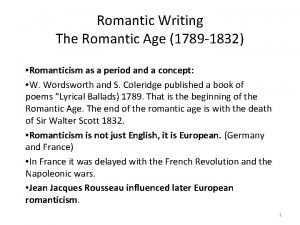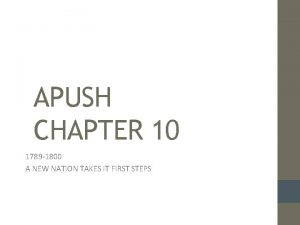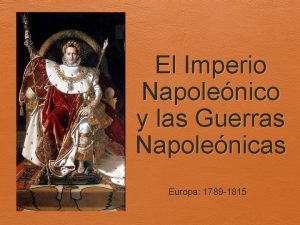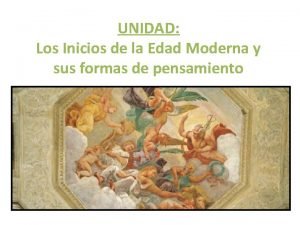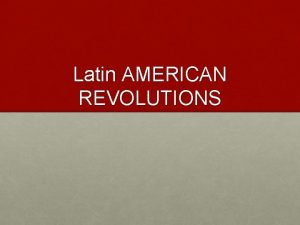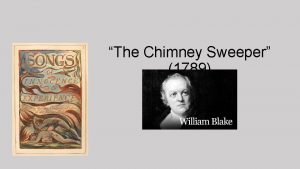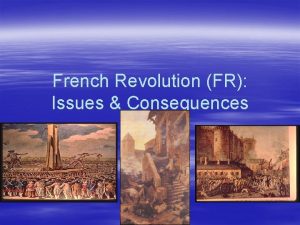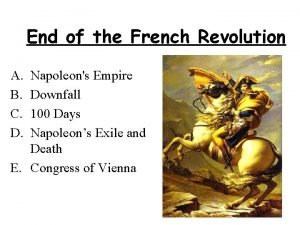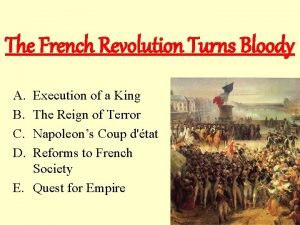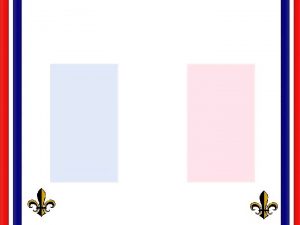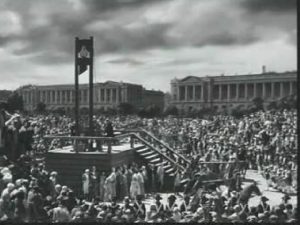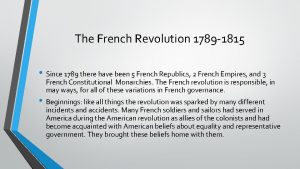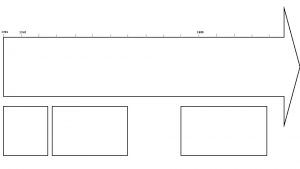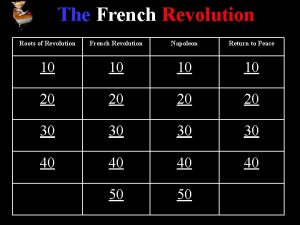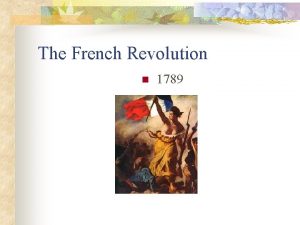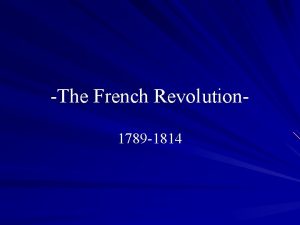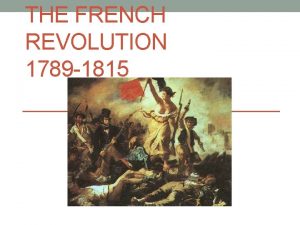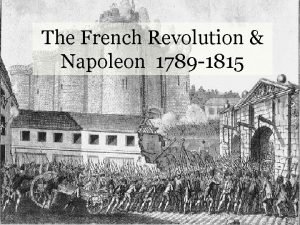The French Revolution 1789 Log on to Edpuzzle

































































- Slides: 65

The French Revolution 1789

Log on to Edpuzzle. Watch Old Regime video • Be prepared to discuss what France was like before the Revolution (OLD REGIME)

OLD REGIME & ESTATES GENERAL In order to understand how the French Revolution changed France, one must first understand the way France was under the Old Regime. Although Louis XIV had done a great deal to build a French nation, France still remained in many ways a patchwork of regions dominated by clerics and aristocrats who made up the First and Second Estates. Due in part to tax exemptions enjoyed by the privileged classes, France found itself in a major financial crisis in the late 1780 s, forcing the monarchy to call a meeting of the Estates General. When the Estates General was convened in 1789, it was convened under antiquated rules that Third Estate delegates found to be offensive. The failure of the Estates General was a watershed event in the French Revolution, opening the door for changes that were far more radical than any that had been proposed by the Third Estate delegates in 1789.

Four phases of the French Revolution 1. “Liberal” Phase (1789 -1791) 2. “Radical” Phase (1792 -1794) 3. Directory Rule (1795 -1799) 4. Napoleonic Era (1799 -1815)

Pre-Revolutionary France (up to 1789) What were the causes of the French Revolution?

Categories of Causes POLITICAL ➔ Discontent w/ absolutist gov’t (Louis XVI and Marie Antoinette) SOCIAL ➔ Outdated social structure (estate system) + inequality of rights and privileges: 1 st – clergy 2 nd – nobility 3 rd – everybody else … bourgeoisie, peasantry, urban poor (98%) IDEOLOGICAL ➔ American Revolution ➔ Enlightenment ECONOMIC ➔ Debt – wars ➔ Poor harvests and bread riots

#1: The French Monarchy Marie Antoinette & Louis XVI (1774 -1793)

Marie Antoinette’s “Peasant Cottage”

Let them eat cake! • “Madame Deficit” • “The Austrian Whore”

#2: An Outdated Social Structure Legal division into 3 orders, or estates: ■ First Estate: Clergy ■ Second Estate: Nobility ■ Third Estate: Commoners (bourgeoisie, peasants, urban poor)

Inequitable Distribution of Land

“The People under the Old Regime”

#3: Enlightenment Ideas Classical Liberalism: Liberty Equality

#4: Model of the American Revolution

#5: Financial Problems

Where is the tax money?

END OF DAY ONE

Phase 1: The “Liberal” Phase (1789 -1791)


May 1789: Estates General meets Last time it was called into session was 1614!!

The Suggested Voting Pattern: Voting by Estates 1 1 1 st Estate – Clergy 2 nd Estate – Nobility 1 3 rd Estate – Commoners

The Number of Representatives in the Estates General: Vote by Head 300 1 st Estate – Clergy 2 nd Estate – Nobility 648 3 rd Estate – Commoners

June 17: National Assembly forms “The Third Estate Awakens”

June 20: Tennis Court Oath “The Tennis Court Oath” by Jacques-Louis David

July 14: Storming the Bastille

July-August: The Great Fear August 4 -11: August Decrees

August 27: Declaration of the Rights of Man and of the Citizen “Men are born free and remain free and equal in rights. ” (…but NOT of Woman)

October 5 -6: Women’s march on Versailles We want the baker, the baker’s wife and the baker’s boy!

More of the National Assembly’s reforms 1. 2. 3. 4. 5. 6. women’s rights: divorce, inheritance, child support rezoning: departments religious toleration of Jews & Protestants abolition of guilds, monopolies, trade barriers Civil Constitution of the Clergy assignats

83 Revolutionary Departments February 26, 1790

Civil Constitution of the Clergy July 12, 1790 • • • national church clergy elected oath of allegiance

Assignats Issued 1789 -1796 They were backed by the sale of Church lands.

September 1791: Louis “accepts” the constitution at the National Assembly CONSTITUTION #1: absolute monarchy → constitutional monarchy 3 branches of government: • king ■ got the “suspensive” veto = could not pass laws for 4 years • Legislative Assembly ■ power to pass laws and grant taxation ■ elected by wealthy men • independent judiciary

While the revolutionaries seemingly got off to a good start… A foreshadowing of events to come….

Phase 2: The “Radical” Phase (1792 -1794)


Attitudes & actions of monarchy Fear of Counter. Revolution The Causes of Instability in France 1792 - 1795 Economic Crises War Political divisions

June 1791: Royal family attempts to to flee Marie Antoinette risks her body to save her son, the crown prince.

War (1792 -1815) Cause: European monarchs dislike turn against monarchy & fear spread of revolution ↓ offer help to French monarchy (Aug. 1791: Declaration of Pillnitz) ↓ French revolutionaries declare war to save the revolution • • April 1792 - vs. Austria, Prussia (“First Coalition”) August 1793 – vs. Britain, Holland, Spain

August 1792: Storming of the Tuileries Royal family imprisoned.

Sept. 2 -7: September Massacres Over 1, 000 Parisians killed!

Sept. 20: National Convention est. • • elected by universal male suffrage legislative branch of the new republic

Sept. 22: First Republic est. (17921795) “second revolution”: constitutional monarchy ↓ republic (CONSTITUTION #2)

The Jacobins Jacobin Club Meeting Jacobin Meeting House ❖Parisian political club ❖younger, more radical than National Assembly members ❖dominated Legislative Assembly & National Convention

The Politics of the National Convention Montagnards “The Mountain” Girondists ❖More radical. ❖More moderate. ❖Power base in Paris. ❖Power base in the provinces. ❖Main support from the sans-culottes. ❖Leaders: Robespierre & Danton ❖Feared the influence of the sans-culottes.


The Sans-culottes: The Parisian Poor Depicted as savages by a British cartoonist.

January 21, 1793: Execution of Louis XVI

April: Committee of Public Safety est. • • 12 -member executive gov’t. during Reign of Terror revolutionary tribunals 300, 000 arrested 16, 000 -50, 000 executed

June 2: The Mountain takes power

October: Execution of Marie Antoinette

1793 -1794: Reign of Terror

The Economy – Committee of Public Safety’s “Total War” Legislation • planned economy – “embryonic emergency socialism” ■ ■ • fixed prices rationing gov’t. -mandated production levels nationalization of businesses Aug. 1973 – conscription EFFECT: France achieved victory in wars.

1794 -1795: Thermidorian Reaction • July 26 → Robespierre gives speech illustrating new plots & conspiracies • July 27 (9 Thermidor) → Convention arrests Robespierre Arrest of Robespierre • July 28 → Robespierre tried & guillotined

Revolutionary Culture How was the Revolution reflected in French popular culture?

The Tricolor is the Fashion

Revolutionary Playing Cards

A New Republican Calendar I 1792 – 1793 II 1793 – 1794 III 1794 – 1795 IV 1795 – 1796 V 1796 – 1797 VI 1797 – 1798 VII 1798 – 1799 VIII 1799 – 1800 IX 1800 – 1801 X 1801 – 1802 XI 1802 – 1803 XII 1803 – 1804 XIII 1804 – 1805 XIV 1805 The Gregorian System returned in 1806.

A New Republican Calendar New Name Meaning Time Period Vendemaire Vintage September 22 – October 21 Brumaire Fog October 22 – November 20 Frimaire Frost November 21 – December 20 Nivose Snow December 21 – January 19 Pluviose Rain January 20 – February 18 Ventose Wind February 19 – March 20 Germinal Budding March 21 – April 19 Floreal Flowers April 20 – May 19 Prairial Meadow May 20 – June 18 Messidor Harvest June 19 – July 18 Thermidor Heat July 19 – August 17 Fructidor Fruit August 18 – September 21

Phase 3: Directory Rule (1795 -1799)

The Directory est. via the Constitution of 1795 (CONSTITUTION #3) (though still the First Republic, 1792 -1804) Government structure: ● 5 -man Directory (executive) ● 2 -house legislature: Council of 500 & Council of Elders ● independent judiciary → suffrage limited to men with property

Problems continued under the Directory. . . • kept France in an unpopular war • economic crises continued • corrupt and dictatorial government ■ ex. 1797 election returned conservative members to government → Directory didn’t like this so nullified the election and ruled by decree

Phase 4: Napoleonic Era (1799 -1815)

Napoleonic Era (1799 -1815) • coup d’etat – overthrew Directory and established dictatorship

Napoleon Bonaparte (1769 -1821)
 What was an immediate cause of the 1789 french revolution
What was an immediate cause of the 1789 french revolution 5th may 1789
5th may 1789 Cause of the french revolution
Cause of the french revolution The tennis court oath
The tennis court oath Akar pangkat 674
Akar pangkat 674 Jika log 2 = 0 301 nilai log 32 =
Jika log 2 = 0 301 nilai log 32 = Jika 4 log 64 = x tentukan nilai x
Jika 4 log 64 = x tentukan nilai x ³log 243=p
³log 243=p 5 log 50 - 5 log 2
5 log 50 - 5 log 2 Jika log 3 = 0 477 dan log 5 = 0 699 nilai dari log 45 =
Jika log 3 = 0 477 dan log 5 = 0 699 nilai dari log 45 = Diketahui log 2=0 301 dan log 3=0 477
Diketahui log 2=0 301 dan log 3=0 477 Persamaan dan pertidaksamaan logaritma
Persamaan dan pertidaksamaan logaritma Russian revolution vs french revolution
Russian revolution vs french revolution You should hope this game will be over soon
You should hope this game will be over soon French estates political cartoon
French estates political cartoon Lorax lessons
Lorax lessons Https://edpuzzle.com/join/
Https://edpuzzle.com/join/ Tagul nedir
Tagul nedir Edpuzzle
Edpuzzle Https://edpuzzle.com/join
Https://edpuzzle.com/join Edpuzzle
Edpuzzle Edpuzzle
Edpuzzle Where does the oxygen that we breathe come from edpuzzle
Where does the oxygen that we breathe come from edpuzzle Edpuzzle
Edpuzzle Pedigree edpuzzle
Pedigree edpuzzle Https://edpuzzle live
Https://edpuzzle live Edpuzzle
Edpuzzle Logarithmic to exponential form
Logarithmic to exponential form Power law log log plot
Power law log log plot Loga mn
Loga mn Azade nazi
Azade nazi 5 properties of logarithms
5 properties of logarithms Log m-log n
Log m-log n Power law log log plot
Power law log log plot Log k = log a - ea/rt
Log k = log a - ea/rt Desmos log log plot
Desmos log log plot Buffer capacity formula
Buffer capacity formula Log exp
Log exp How to get rid of ln with e
How to get rid of ln with e Modelo reciproco
Modelo reciproco Log a - log b
Log a - log b Persamaan 7 log 217 + 7 log 31 ialah
Persamaan 7 log 217 + 7 log 31 ialah Green revolution vs third agricultural revolution
Green revolution vs third agricultural revolution 1797 - 1789
1797 - 1789 Bolton romanticism amp; politics 1789 1832 download
Bolton romanticism amp; politics 1789 1832 download 1789 apush
1789 apush Art 1789
Art 1789 Europa en 1789
Europa en 1789 July 14 1789
July 14 1789 Louis xiv en costume de sacre symboles
Louis xiv en costume de sacre symboles 1789
1789 Edad antigua linea del tiempo
Edad antigua linea del tiempo Symbol of the french revolution
Symbol of the french revolution 1789 france
1789 france Napoleon 1789
Napoleon 1789 The divisions in spanish colonial society 1789
The divisions in spanish colonial society 1789 The chimney sweeper songs of innocence
The chimney sweeper songs of innocence Europe in 1789
Europe in 1789 Against the gods 1789
Against the gods 1789 Sistema internacional clasico
Sistema internacional clasico French revolution abcs
French revolution abcs French absolutism enlightenment & revolution
French absolutism enlightenment & revolution Committee of public safety
Committee of public safety Abc french revolution
Abc french revolution The french revolution
The french revolution Chapter 11 the french revolution and napoleon
Chapter 11 the french revolution and napoleon


